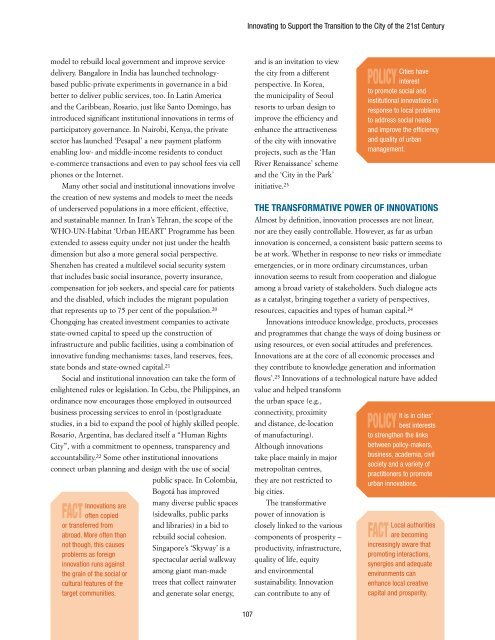state of the world's cities 2012/2013 - United Nations Sustainable ...
state of the world's cities 2012/2013 - United Nations Sustainable ...
state of the world's cities 2012/2013 - United Nations Sustainable ...
Create successful ePaper yourself
Turn your PDF publications into a flip-book with our unique Google optimized e-Paper software.
Innovating to Support <strong>the</strong> Transition to <strong>the</strong> City <strong>of</strong> <strong>the</strong> 21st Centurymodel to rebuild local government and improve servicedelivery. Bangalore in India has launched technologybasedpublic-private experiments in governance in a bidbetter to deliver public services, too. In Latin Americaand <strong>the</strong> Caribbean, Rosario, just like Santo Domingo, hasintroduced significant institutional innovations in terms <strong>of</strong>participatory governance. In Nairobi, Kenya, <strong>the</strong> privatesector has launched ‘Pesapal’ a new payment platformenabling low- and middle-income residents to conducte-commerce transactions and even to pay school fees via cellphones or <strong>the</strong> Internet.Many o<strong>the</strong>r social and institutional innovations involve<strong>the</strong> creation <strong>of</strong> new systems and models to meet <strong>the</strong> needs<strong>of</strong> underserved populations in a more efficient, effective,and sustainable manner. In Iran’s Tehran, <strong>the</strong> scope <strong>of</strong> <strong>the</strong>WHO-UN-Habitat ‘Urban HEART’ Programme has beenextended to assess equity under not just under <strong>the</strong> healthdimension but also a more general social perspective.Shenzhen has created a multilevel social security systemthat includes basic social insurance, poverty insurance,compensation for job seekers, and special care for patientsand <strong>the</strong> disabled, which includes <strong>the</strong> migrant populationthat represents up to 75 per cent <strong>of</strong> <strong>the</strong> population. 20Chongqing has created investment companies to activate<strong>state</strong>-owned capital to speed up <strong>the</strong> construction <strong>of</strong>infrastructure and public facilities, using a combination <strong>of</strong>innovative funding mechanisms: taxes, land reserves, fees,<strong>state</strong> bonds and <strong>state</strong>-owned capital. 21Social and institutional innovation can take <strong>the</strong> form <strong>of</strong>enlightened rules or legislation. In Cebu, <strong>the</strong> Philippines, anordinance now encourages those employed in outsourcedbusiness processing services to enrol in (post)graduatestudies, in a bid to expand <strong>the</strong> pool <strong>of</strong> highly skilled people.Rosario, Argentina, has declared itself a “Human RightsCity”, with a commitment to openness, transparency andaccountability. 22 Some o<strong>the</strong>r institutional innovationsconnect urban planning and design with <strong>the</strong> use <strong>of</strong> socialpublic space. In Colombia,Bogotá has improvedInnovations aremany diverse public spacesfact <strong>of</strong>ten copied (sidewalks, public parksor transferred fromand libraries) in a bid toabroad. More <strong>of</strong>ten than rebuild social cohesion.not though, this causesSingapore’s ‘Skyway’ is aproblems as foreignspectacular aerial walkwayinnovation runs against<strong>the</strong> grain <strong>of</strong> <strong>the</strong> social oramong giant man-madecultural features <strong>of</strong> <strong>the</strong> trees that collect rainwatertarget communities. and generate solar energy,and is an invitation to view<strong>the</strong> city from a differentperspective. In Korea,<strong>the</strong> municipality <strong>of</strong> Seoulresorts to urban design toimprove <strong>the</strong> efficiency andenhance <strong>the</strong> attractiveness<strong>of</strong> <strong>the</strong> city with innovativeprojects, such as <strong>the</strong> ‘HanRiver Renaissance’ schemeand <strong>the</strong> ‘City in <strong>the</strong> Park’initiative. 23policyCities haveinterestto promote social andinstitutional innovations inresponse to local problemsto address social needsand improve <strong>the</strong> efficiencyand quality <strong>of</strong> urbanmanagement.The Transformative Power <strong>of</strong> InnovationsAlmost by definition, innovation processes are not linear,nor are <strong>the</strong>y easily controllable. However, as far as urbaninnovation is concerned, a consistent basic pattern seems tobe at work. Whe<strong>the</strong>r in response to new risks or immediateemergencies, or in more ordinary circumstances, urbaninnovation seems to result from cooperation and dialogueamong a broad variety <strong>of</strong> stakeholders. Such dialogue actsas a catalyst, bringing toge<strong>the</strong>r a variety <strong>of</strong> perspectives,resources, capa<strong>cities</strong> and types <strong>of</strong> human capital. 24Innovations introduce knowledge, products, processesand programmes that change <strong>the</strong> ways <strong>of</strong> doing business orusing resources, or even social attitudes and preferences.Innovations are at <strong>the</strong> core <strong>of</strong> all economic processes and<strong>the</strong>y contribute to knowledge generation and informationflows’. 25 Innovations <strong>of</strong> a technological nature have addedvalue and helped transform<strong>the</strong> urban space (e.g.,connectivity, proximityIt is in <strong>cities</strong>’and distance, de-location policy best interests<strong>of</strong> manufacturing).to streng<strong>the</strong>n <strong>the</strong> linksAlthough innovationsbetween policy-makers,take place mainly in majorbusiness, academia, civilsociety and a variety <strong>of</strong>metropolitan centres,practitioners to promote<strong>the</strong>y are not restricted tourban innovations.big <strong>cities</strong>.The transformativepower <strong>of</strong> innovation isclosely linked to <strong>the</strong> variousLocal authoritiescomponents <strong>of</strong> prosperity – fact are becomingincreasingly aware thatproductivity, infrastructure,promoting interactions,quality <strong>of</strong> life, equitysynergies and adequateand environmentalenvironments cansustainability. Innovation enhance local creativecan contribute to any <strong>of</strong>capital and prosperity.107





